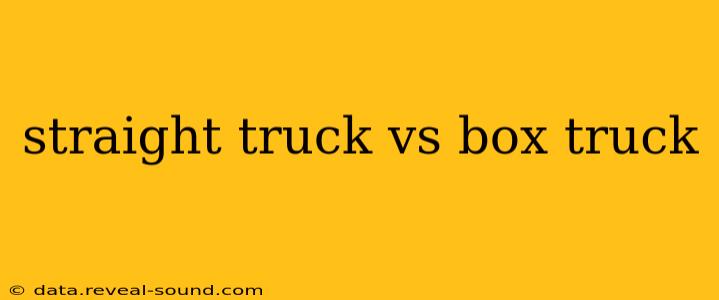Choosing between a straight truck and a box truck depends heavily on your specific needs. Both are popular commercial vehicles used for transporting goods, but they differ significantly in design, capacity, and maneuverability. This comprehensive guide will explore the key distinctions to help you make an informed decision.
What is a Straight Truck?
A straight truck, also known as a single-unit truck, is a single vehicle with a cab and a cargo area directly behind it. It doesn't use a separate trailer. This configuration offers excellent maneuverability, making it ideal for navigating tight city streets and smaller delivery areas. Straight trucks come in various sizes, from smaller versions suitable for local deliveries to larger ones capable of handling substantial loads. They’re often preferred for their versatility and ease of operation.
What is a Box Truck?
A box truck is a type of straight truck characterized by its enclosed cargo area, typically a rectangular box built onto the chassis. This enclosed space provides excellent protection for goods from the elements and theft, making it suitable for transporting sensitive or valuable items. Box trucks also come in various sizes, ranging from smaller units used for courier services to larger ones capable of carrying significant weight. The enclosed nature, however, can sometimes make loading and unloading slightly more challenging than with an open-bed straight truck.
Straight Truck vs. Box Truck: Key Differences Summarized
| Feature | Straight Truck | Box Truck |
|---|---|---|
| Cargo Area | Can be open bed, flatbed, or enclosed | Always enclosed |
| Maneuverability | Generally more maneuverable | Less maneuverable than smaller straight trucks |
| Cargo Protection | Varies depending on the type of cargo area | Excellent protection from elements & theft |
| Loading/Unloading | Often easier for certain cargo types | Can be more challenging due to enclosed space |
| Cost | Generally less expensive to purchase and operate | Can be more expensive |
| Applications | Local deliveries, construction materials, etc. | Furniture removal, courier services, etc. |
What are the Different Types of Straight Trucks?
While the term "straight truck" is broad, it encompasses various configurations depending on the cargo area. These include:
- Flatbed Trucks: These trucks have an open, flat platform for carrying large, non-fragile items.
- Stake Trucks: Similar to flatbeds, but with sides and stakes for added security.
- Curtain-Side Trucks: Feature curtains instead of solid sides, allowing easier access to cargo.
- Dump Trucks: Designed for hauling loose materials like gravel or dirt.
These variations offer flexibility depending on the type of goods being transported.
What is the Best Truck for My Business?
The "best" truck depends entirely on your specific business needs. Consider these factors:
- Cargo type: Fragile goods require enclosed space, while large, non-fragile items might be better suited for a flatbed.
- Delivery radius: Frequent city driving favors more maneuverable straight trucks. Longer distances might justify a larger, potentially less maneuverable truck.
- Budget: Straight trucks are generally less expensive to purchase and maintain than larger box trucks.
- Loading/unloading requirements: Consider the ease of access to the cargo area.
How Much Does a Straight Truck Cost Compared to a Box Truck?
The cost varies drastically depending on size, age, features, and condition. Generally, smaller straight trucks tend to be more affordable upfront than larger box trucks. However, operating costs (fuel, maintenance) should also be factored into the overall cost of ownership.
What are the Legal Requirements for Operating Straight Trucks and Box Trucks?
The specific legal requirements (licensing, permits, etc.) vary by location and vehicle size. Check with your local Department of Motor Vehicles (DMV) or equivalent agency for detailed information about licensing and other regulations relevant to your area and the size of the truck you intend to operate.
This detailed comparison should provide a clearer understanding of the differences between straight trucks and box trucks, allowing you to make a more informed choice based on your specific transportation needs. Remember to always consult with professionals and consider your budget, operational requirements, and legal obligations when making your decision.
